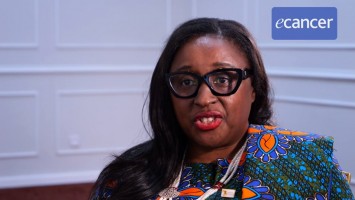I’m going to talk about how we would like to create predictive models on risk of treatment because all research the main aim in clinical practice is to reduce or cure disease but that comes with side effects. Especially in patients you cannot cure anymore the balance between side effects and treatment becomes far more important. So you need to know what are you going to cost and what are you going to win. So we are looking into the possibility to create a tool based on a population who have already come to that clinic or to that region with the same problem who are going to have that treatment and what will be the expected risk that complications occur, not in terms of response but also in severe complications.
How is this linked to the platform that you’re currently working on?
In the beginning of the creation of the Global Health summit I was creating a second opinion platform for oncology clinics giving clinical guidance on certain problems or patients they were facing wherever in the world but it was mainly focussed on Africa. The problem I ran directly into was that if I say, ‘Okay, this certain case needs radiation or needs chemotherapy,’ then the problem was where will I get that? Here I cannot do it or that drug is not available or I have the radiation machine in another country, is it worthwhile? What should I ask them to do there. So we joined together with the technical team side to create a certain quality measurement for radiation therapy so that when we advise a certain treatment they could help those clinics having them the technical details of really delivering that quality treatment.
So I created weCancerTALK, giving the information educational side, the medical advice side together with his side on the technical and delivery of treatment side. Together when we started out to create a website or an app is not so complicated but you need experts behind who then can take on quests and tasks to answer all the questions. So from the first summit on we created a pool of diaspora doctors mainly trained in Harvard but also outside Harvard who come from African countries or from some islands, now they’re starting to join the effort too. They feel very honoured but also privileged doing their exam and their formation here and they want to give back but they don’t want to move back to Rwanda or Jamaica. They have their families here, they have their work here. So what we did we created that list and they are volunteering. So if there is a question coming out they will volunteer to respond. So that reduces the cost for the local clinics enormously because when we look at the normal second opinion platforms with doctors or whatever you pay easily $700-800 to have a ten minute opinion. So we didn’t want to play in that price range.
What we tried to do is to create the opinions for a cheaper rate or for a zero rate for the clinics but then we have to create revenue somewhere else. So what we now are doing is while creating the responses we generate data and we’re going to use that data to create predictive models.
How does the data modelling and learning algorithm work?
How treatment is working and being efficient or creating side effects is directly related not only to the disease but also to the person who gets it. So a person in Africa has a different genetic profile, has a different environmental profile, spending, hygiene, everything is different. So when we learn algorithms in the Western world we cannot just put them on a cohort elsewhere and vice versa. So we need to train those algorithms in the cohorts who are facing the treatment. So the algorithm is already trained in more Western cohorts so it’s not that they start from scratch but the fact of what diseases, what treatment is it and how old the person is, is it a female or a man – very classical risk factors or factors that will play are there in both cohorts. So you start the algorithm with that and we need the population data elsewhere, in China, Africa, the Middle East, whatever, to train it. Then you get a predictive tool saying, okay, doctor wherever he is is going to give drug A to a patient X. He has the factors of patient X and he will plug in the drug saying, okay, what else happened before and what are my chances of response but also what are the risks of side effects. That risk which is 30% or 5% or 60% needs to be based on at least a thousand patients in more or less the same region with more or less the same stage etc. So you need that background to get to a certain tool like that. But I’m completely sure that in a couple of years we will be there because of the volume we have been facing but also because of the technical tools we have today.
Is there anything you’d like to add?
I really hope that investors keep helping us to do that work because in deep learning we had very enthusiastic reactions and then we had some disappointments, especially in health because we did not take that regional factor into account. So we took a cohort to work on who were far not homogeneous enough. So I hope we can get to enthusiasm with investors again that still believe that we can do this.








